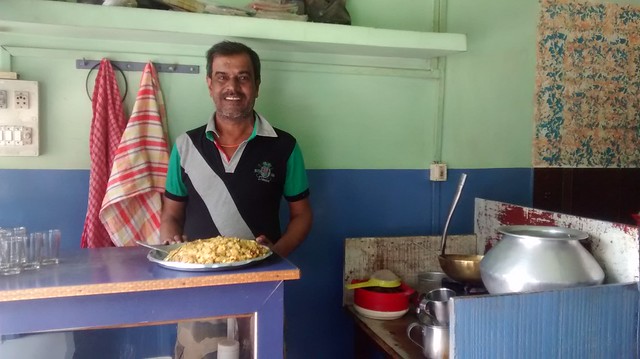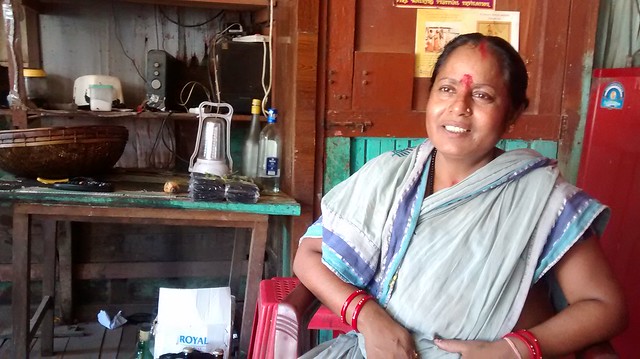By Amit Kumar, TwoCircles.net
Imphal, Manipur: Anil Kumar Gupta, 56, runs a tea stall in Imphal. Although his roots go back to Samastipur, Bihar, he has never been there. His father moved to Imphal long before Anil was born, and Imphal has always been home for him and his family. He speaks chaste Bhojpuri with hundreds of Biharis who visit his shop, but is equally, if not more, fluent in Manipuri. He subscribes to a Manipuri newspaper and the music system in his shop plays mostly Manipuri music. “I am more Manipuri than the guy who works in my shop,” he says laughingly. “He has been to Delhi; I have never been beyond Guwahati,” he adds.

Anil Kumar Gupta, a resident of Imphal in his tea shop.
He insists that he has never been discriminated by the Meiteis living in the area and that the entire debate over the Inner Line Permit issue has not impacted his life in any possible way. However, he adds that it is not as if he is not worried; just that he knows he can do little about it.”This is not the first time that Meyangs (Manipuri term for outsiders) have been targeted in Manipur. Similar incidents have happened in the early 80s and 90s too. We survived all that, we will survive this too,” he says.
The three Bills: The Manipur Land Revenue and Land Reforms (Seventh) Amendment Bill 2015 (MLRLR Bill 2015), The Protection of Manipur People Bill, 2015 and The Manipur Shops and Establishments Act (Second) Amendment Bill 2015, are being presented by the Government of Manipur as a ‘solution’ to long pending demand for implementation of Inner Line Permit system by the Meitei organizations to protect them from the high rate of influx of outsiders.The Inner Line Permit is a special permit required to enter certain restricted areas in the country, and currently such a system exists in Arunachal Pradesh, Nagaland and Mizoram.
The Joint Committee on Inner Line Permit System (JCILPS) has been spearheading the movement for legislation to “protect the indigenous population from migrants.”The reaction to these Bills have varied in the state, with immense support for passing them in the four valley districts of the region–Imphal East, Imphal West, Thoubal and Bishnupur–while the Hill districts are opposing them completely.
However, in all these debates, the ‘outsiders’, much like the Manipuri Muslims, have mostly been left out. But Anil believes this is understandable given that at least in the valley districts, the main agitation is against the huge influx of non-Manipuris. However, he adds that outsiders who are now residents of the region and have voting rights in the districts must be discussed and spoken to. “It is common to see videos of outsiders being attacked in the Imphal region. Every once in a while, such a video pops up on WhatsApp. This worries us a lot, but we are not in a position to do much,” he says.
About 110 kms from Imphal, in Moreh too, the Biharis are worried over the ILP issue. However, the equation in Moreh, Chandel district, is slightly different in this border town. Despite being a small town, Moreh has a cosmopolitan society, with Meiteis, Kukis, Biharis, Tamils and Punjabis all living as residents in the region, and Biharis form a majority of the labour force in the town. Ramkali Devi, who is from Bihar, runs a small hotel in the town and as a resident, has witnessed a lot of confrontations over the ILP issue. While she has never been attacked, she is well aware of the dangers.”The main stakeholders in this fight are the Kukis and Meiteis in this region. We have mostly been mute spectators, but we are not out of danger. About six months ago, Meiteis took out a rally in support of ILP and a number of shops, including mine, were damaged,” she says. “I am not even sure what the ILP means. I have a shop here and voting rights too. Will my rights be taken away once ILP comes into place? Will we be asked to leave?” she asks.
Lack of clarity over ILP the biggest concern for migrants
Whether it is in Imphal, Moreh or Churachandpur, migrants across the state are confused and worried about what the ILP issue entails. Rumours and lies spread by various people have not helped matters, says Pradip Phanjoubam, editor, Imphal Free Press. “Let’s clear one thing: even if ILP comes into place, no outsider will be thrown out of the state or asked to leave. Similarly, no one will be disenfranchised. The biggest impact, at least in the near future, will be that it will become difficult, if not impossible, for outsiders to buy land in the region. But fears that ILP will bring a mass exodus from the region, are unfounded,” he says.

Ramkali Devi in her hotel in Moreh
Then, there is the issue of using 1951 as the base year for defining who the residents of Manipur are. Even Anil, who is 56 years old and has spent all his life in the state does not qualify as a Manipuri as per the base year. The base year, says Phanjoubam, has been the biggest point of debate and clearly must be addressed. “Instead of using 1951 as a base year, residency should be defined like domicile status. If you meet the requirements for domicile status in the state, you must also qualify as a Manipuri,” he says.
Outsiders need not fear, says JCILPS
According to BK Moirangcha, Convener in charge, JCILPS, the demand for ILP is an attempt to preserve the Manipuri ethnic population. “Some people are looking at it as Meiteis against everyone else,” he told Twocircles.net. “We are not against people from outside, but at the same time, we believe that we must be allowed to protect ourselves from the huge influx of outsiders in the state. Bringing in ILP will not mean you (an outsider) cannot come and stay; it is simply an attempt to keep a check on how many people arrive in the state, and to stop them from acquiring land in the region,” he says. He added that people who had been living in the state as per the base year are Manipuris irrespective of whether they are ethnic people or not. He refused to answer clearly on the issue of the base year itself, saying that this was up to the state government to decide after consulting all the concerned parties.
However, one of the members of the committee told Twocircles.net on the condition of anonymity that there was a good chance that the base year might be shifted to a later period to make the Bills more inclusive. “Our main demand has always been, and remains, the need to introduce ILP. We are ready to discuss other points but there is no way we will let this demand go,” he said. “People have lost lives fighting for this issue and there is no way we will let their sacrifices go in vain,” he said pointing to the burial site of Sapam Robin Hood, where he had met this correspondent. On July 8, 2015, 16-year-old Robin died after a tear gas shell hit his neck. Currently, a road is being constructed near his burial site in Loumai Ching Khong, which is a few kms from the Porompat D.C. office. This July, the JCILPS plans to host a program in the memory of Robin on his death anniversary.
It is pretty clear that the demand for ILP is unlikely to subside in the valley region, just as there is little chance that the tribal regions will stop opposing the three Bills. However, in the simmering political cauldron that Manipur has become, it will be difficult to predict who gets caught on the wrong side. For now, however, the Biharis can only wait and watch.
Related:
294 days and counting: Why Churachandpur refuses to bury its dead
Why tribals of Manipur won’t accept the controversial Bills pushed by the state government
Manipuri Muslims feel left out, sidelined over Inner Line Permit issue
For Tamils of Moreh, staying out of the Inner Line Permit debate is the safest option
